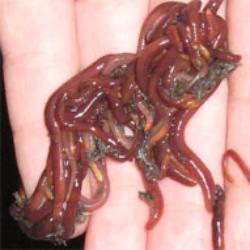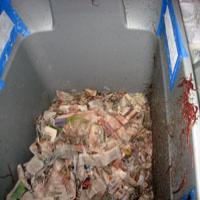![Hands sift through compost ready for use. [credit: uf/ifas]](/media/sfylifasufledu/sarasota/images/banner1650x470/2015_Comms_T4_compostHands_1650w.jpg)
COMPOSTING WITH WORMS (VERMICOMPOSTING)
Composting with worms – also known as "vermicomposting" – is the process of using worms to produce rich compost from kitchen wastes. One pound of worms can turn 65 pounds of garbage into garden compost in 100 days. It is the way to go if you live in an apartment or if you generate mostly food scraps.

Red wiggler worms
Food scraps from plants will best suit your worms for composting. This includes vegetable and fruit trimmings, coffee grounds, pasta, bread, cereal, tea bags, and various paper products. Plate scrapings are also acceptable. Animal products such as meat, eggs cheese, etc. are best kept to a minimum to prevent odors.
If you want to set up your own vermicomposting system, simply follow the steps below. Click any step below to learn more (show all steps).
Step 1: Make a Worm Bin
Materials Needed

Worm bin
- 1 18-gallon plastic container with lid
- window screen (can be old)
- duct tape
- sections of newspaper, shredded paper, or paperboard (cereal boxes)
- water
- a couple of handfuls of sand or soil
- electric drill with 1-inch spade bit
- 1/2–1 pound of worms*
*Just any worms won't do! Locate red wigglers or African nightcrawlers. These worms are excellent composters and thrive in a worm bin environment. Red wigglers reproduce more quickly and are smaller than African nightcrawlers; both are good fish bait. Local worm farms or bait stores can usually provide these types of worms.
Worm Bin Construction
- Drill four holes (two per side) about four inches from the top of the bin.
- Cut small pieces of screen large enough to cover the holes and tape them to the inside of the bin using duct tape.
- Make a bedding by shredding paper lengthwise into 1-inch strips to fill the bin 1/3 full.
- Spread sand or soil over the bedding.
- Pour the water over the newspaper strips; stirring the bedding as you moisten it.
- Dump worms out of containers onto surface of bedding. After two hours, remove any (dead) worms that have not wiggled down into bedding.
Step 2: Vermicompost! Care for Your Worms
Feeding
One pound of worms can process half a pound of kitchen scraps each day. Feed them daily, weekly or as desired. Cutting the scraps into small pieces allows the worms to consume them faster. Bury the scraps under the bedding; rotate where you bury them. You may add more bedding every once in a while.
Temperature
The ideal temperature for worms is between 60-80 degrees F. So, place the bin in a shady area, not in direct sun.
Moisture
Check the moisture when adding kitchen scraps. If it is too wet, add more bedding; if too dry, add water. Worms like more moisture than you might think. Experiment with the moisture levels to find your best results.
Darkness
Keep the lid on your bin. Worms do not like light, and the closed bin will not attract flies.
Step 3: Harvesting Compost and/or Worms

Worm compost
After two or three months, the worms will have converted the bedding and food scraps into a rich, dark compost. there are two ways to harvest it:
- Gently push the compost to one end of the bin and fill the empty side with moistened, shredded newspaper. Place kitchen scraps into bedding. The worms will eventually leave the compost and migrate towards the food. The compost can then be removed.
- To harvest the worms and compost at the same time, dump the contents of the bin onto a piece of plastic. Allow the worms time to retreat to the middle of the pile away from the light, then scrape off the outer layer of compost. Repeat this procedure until all the compost is harvested and mostly worms are left.
Share some of your worms with others and/or return them to the bin filled with fresh, moistened bedding. Add one cup of soil or sand and some food. Begin again!
Learn More
- Natural Resources